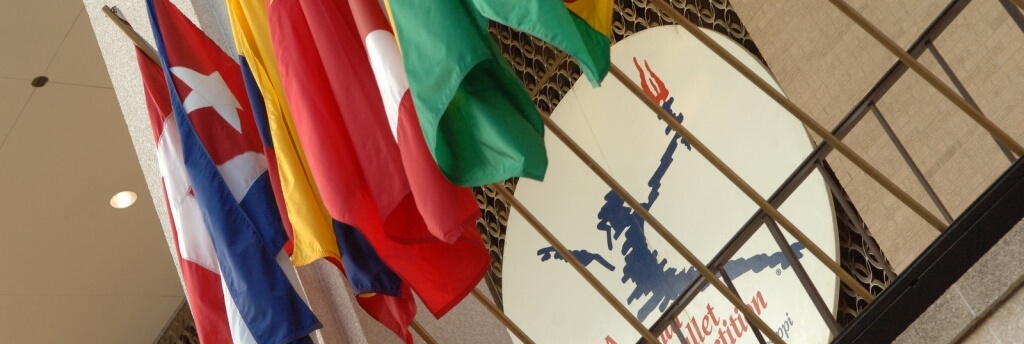JACKSON – Inspiration, encouragement, and humility cannot begin to describe the array of emotions audience members felt during the latest production of Tunes, Tutus & Turning Wheels, which by design blends dancers and artists with and without disabilities. Over 350 people ventured to the Belhaven Concert Hall Oct. 29 to witness a variety of performances from classical ballet to contemporary modern works. The event is presented by the USA International Ballet Competition and VSA Mississippi in collaboration with Methodist Rehabilitation Center, Mississippi Paralysis Association and Belhaven University.
TTTW brings the Jackson community together to celebrate life and promote disability awareness. It has done so four times since 2005.
“The presence of a disability does not mean a person is without ability. It brings me delight to see the program bring the dance and art communities together and blossom each time,” said Sue Lobrano, creator of TTTW and USA IBC executive director.
Several pieces inside the performances showcased performers with physical and/or internal disabilities who skillfully execute feelings and emotions through dance.
Belhaven senior, Whitney Dufrene, enchanted the audience through her performance to “His Eyes are on the Sparrow,” choreographed by Cynthia Newland, chair of Belhaven’s dance department and TTTW director. Dufrene was born with Nystagmus-an uncontrolled movement of the eyes, which disables her from seeing in a straight line and hinders many day-to-day tasks such as driving and looking others in the eye. At the beginning of the piece, a video of Dufrene explained her disability and her coping strategies. Dufrene explained that in times of struggle she places everything on the shoulders of Jesus Christ. The performance inspired the audience as well as Dufrene, who said she felt as if in flight.
“The piece is an expression of the Lord’s joy and peace,” said Dufrene, “even though I can’t always see down a straight path, He can. That is all that matters.”
A piece entitled “Whisper,” featured children from The Little Lighthouse of Mississippi and choreography by Newland. The performance began with performers dressed in black and white dancing in very strict rigid movements to portray a life without love. As the performance evolved, Jessica Ziegelbauer entered the stage with a guitar in hand to serenade the audience with the song “Lovely.” Color and life were added to the movements and costumes, and finally nine children from the Little Light House were brought to the stage for patty-cake, skips, pointed toes, and acts of gentility toward one another. Their contagious giggles and bright smiles, while being delicately led by older dancers, contributed to the message that each life is a celebration.
Nicole Marquez joined the cast of TTTW for a second time. Her first dance after falling six stories from her New York apartment was at TTTW 2009. She contrasted the two performances stating the first was one of excitement and making memories followed by some criticism of herself for not “doing more.” In TTTW 2011, she relates “I am doing more. It’s never enough.”
She describes the magic moment of adrenaline, excitement, fear, and panic waiting in the wings. The magnitude of three or four months work for a five minute payoff is tremendous, but that is when she reminds herself, “this is my life; I am a dancer.”
This year’s piece entitled “(T)here” brought together Marquez and long-time TTTW performer, Tom Burnley, in choreography by Mark Tomasic of Dancing Wheels, an integrated dance company, in Cleveland, OH. It began with large wording – unexpected, home, frightened, peace – handwritten upon paper airplanes showcased on a back screen as the light falls upon Marquez who is seated but stands triumphantly with a crescendo.
Marquez also expressed her thanks for the arts supporters, especially those of TTTW. “I thank them for their support of time, effort, energies and funds! Supporters allow us to perform, but they balance our performance by giving us the tools and opportunities to bring them the joy they deserve as an audience. Jackson is thriving on the arts now; keep the momentum.”
Burnley was introduced to the program years ago while a patient of Methodist Rehabilitation Center. He quickly fell in love with the arts. Burnley returns to the stage each TTTW performance as a veteran though no longer a MRC patient because he enjoys the camaraderie between the diverse cast ensemble. He admits that this year’s choreography seemed challenging at first. He immediately gives credit to his partner, Brigette Marquardt, a Belhaven student, for assisting his triumph over it.
“Participating in Tunes, gives me a chance to participate in the arts that I didn’t have before,” commented Burnley.
Audience members waited patiently to witness the most anticipated piece titled, “Point to Pointe.” Also choreographed by Newland, this piece featured Ryan Estep and Tremaine Nathan, members of the Methodist Rehabilitation Center’s wheelchair fencing team. Both fencers have been involved in fencing competitions and Estep is ranked ninth in the world. He will also represent the USA in the Paralympics in 2012. Estep admitted that the transformation from fencer to dancer was quite interesting.
“I’m used to trying to hurt people, not dancing,” commented Estep.
After being involved in the performance process his respect for dancers increased.
“In ‘Point to Pointe’, the playfulness of healthy competition and the athleticism of the dancers and the fencers come into play, confirming the vigor of both art forms,” said Newland. “Although terminology differs, both involve eloquent grace and the power of articulate and precise execution.”
The audience did not stifle their laughter as the two fencers – at one point – learned a lesson or two from the ballerinas.
USA IBC produces TTTW to provide an opportunity of self expression for dancers (and artists) with (and without) disabilities while generating disability awareness to the audience in attendance and support the community at large.

